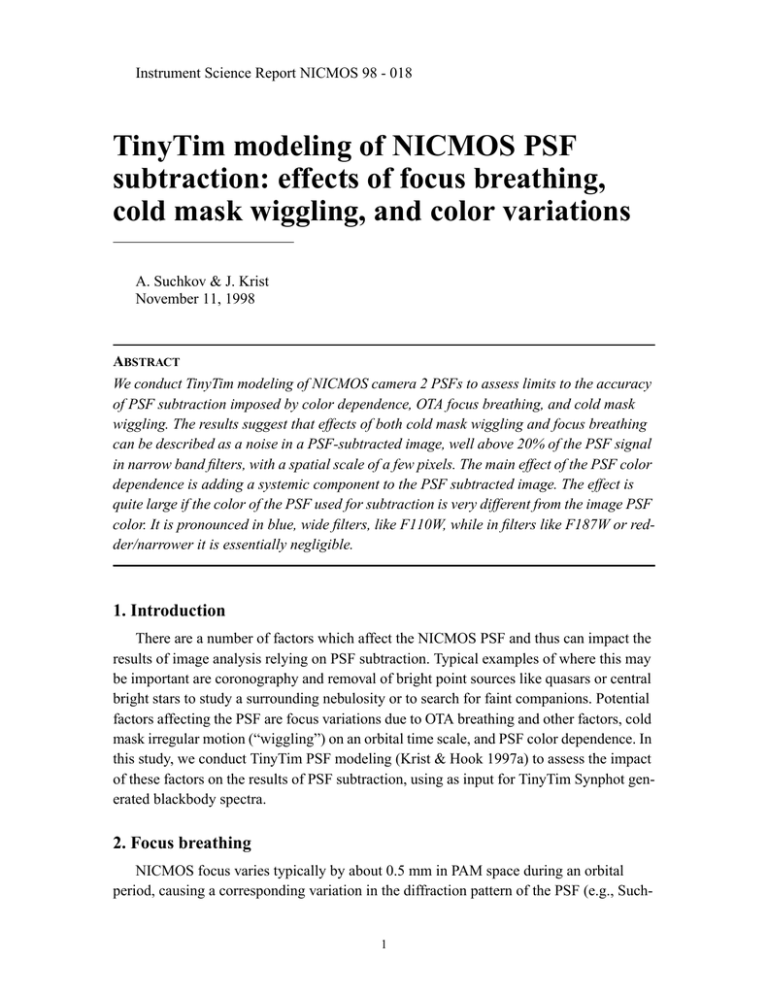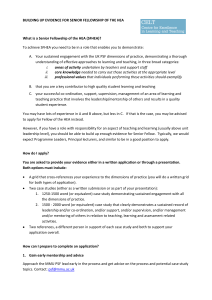TinyTim modeling of NICMOS PSF subtraction: effects of focus breathing,
advertisement

Instrument Science Report NICMOS 98 - 018 TinyTim modeling of NICMOS PSF subtraction: effects of focus breathing, cold mask wiggling, and color variations A. Suchkov & J. Krist November 11, 1998 ABSTRACT We conduct TinyTim modeling of NICMOS camera 2 PSFs to assess limits to the accuracy of PSF subtraction imposed by color dependence, OTA focus breathing, and cold mask wiggling. The results suggest that effects of both cold mask wiggling and focus breathing can be described as a noise in a PSF-subtracted image, well above 20% of the PSF signal in narrow band filters, with a spatial scale of a few pixels. The main effect of the PSF color dependence is adding a systemic component to the PSF subtracted image. The effect is quite large if the color of the PSF used for subtraction is very different from the image PSF color. It is pronounced in blue, wide filters, like F110W, while in filters like F187W or redder/narrower it is essentially negligible. 1. Introduction There are a number of factors which affect the NICMOS PSF and thus can impact the results of image analysis relying on PSF subtraction. Typical examples of where this may be important are coronography and removal of bright point sources like quasars or central bright stars to study a surrounding nebulosity or to search for faint companions. Potential factors affecting the PSF are focus variations due to OTA breathing and other factors, cold mask irregular motion (“wiggling”) on an orbital time scale, and PSF color dependence. In this study, we conduct TinyTim PSF modeling (Krist & Hook 1997a) to assess the impact of these factors on the results of PSF subtraction, using as input for TinyTim Synphot generated blackbody spectra. 2. Focus breathing NICMOS focus varies typically by about 0.5 mm in PAM space during an orbital period, causing a corresponding variation in the diffraction pattern of the PSF (e.g., Such- 1 kov & Hershey 1998). Therefore, if the same reference PSF is used for PSF subtraction in frames taken at different times, certain errors will be introduced in the final results. To assess those, we have generated a PSF at the best focus position and another at a defocus of 0.5 mm. In both cases the same 8000 K blackbody spectrum convolved with the filter throughput has been used. The difference between the two PSFs should obviously depend on the filter used, with narrow band filters yielding larger difference. We have modeled the situation for two filters, F187W and F187N, to illustrate how the filter bandwidth affects the PSF variation caused by defocussing. The results are presented in Figures 1 and 2, the case of the broad band filter at the top and that of the narrow band filter at the bottom. Table 1. Mean and standard deviation of the PSF subtraction residuals computed as a percent of the PSF pixel values (for model parameters see the text). Mean is at the top and standard deviation (sigma) is at the bottom in each of the five rows. Standard deviation can be interpreted as the average relative spatial noise expressed as a percent of the PSF pixel value at any given distance from the PSF center. Mean represents a systemic component in the PSF residuals. mean/ sigma (F110W) mean/ sigma (F187W) color dependence (8000K-3000K) 23.50% 8.91% 0.58% 1.57% color dependence (8000K-6000K) -1.52% 1.32% color dependence (6000K-3000K) 25.31% 7.32% model focus variation mean/ sigma (F187W) mean/ sigma (F187N) 0.62% 6.81% 1.86% 17.29% cold mask wiggling mean/ sigma (F160W) mean/ sigma (F187N) 0.10% 14.38% 3.15% 37.67% The left panels in Figure 1 show the counts in the central column for the nominal and defocused PSFs (thin lines) as well as the result of subtraction of these columns (thick line). The right panels give the counts difference for the same columns as a percent of the respective pixel value of the in-focus (nominal) PSF. Figure 2 displays on the logarithmic scale the residuals of the PSF subtraction (left panels). The same residuals normalized to the pixel values of the nominal PSF are given in the right panels of that Figure (also on the log scale). Inspection of these figures suggests that the main effect of focus breathing is adding a random spatial noise with a typical scale of a few pixels. As expected, the effect is more pronounced in the narrow band filter. In the wings of the PSF, the amplitude of the noise is quite significant, exceeding 20% of the PSF signal in the case of a broad band filter (F187W in Figure 1). For the narrow band filter F187N, the amplitude soars above 50% 2 level. The average relative noise over the entire PSF region displayed in Figure 2 is given in Table 1 (see bottom numbers in the first row). For F187N, one may expect the average subtraction noise associated with typical orbital focus variations to exceed 15% of the PSF signal. For F187W, the average noise is about three times lower. These numbers are quite significant, and it is useful to keep them in mind when estimating the signal-to-noise ratio for an image after PSF subtraction. Figure 1: Effect of focus variation on PSF subtraction for broad band and narrow band filters. Left panels: normalized counts in the central column of the TinyTim 8000 K blackbody PSF at the best focus and at a defocus of 0.5 mm in PAM space (thin lines). The thick line is the counts difference. Right panels: absolute value of counts difference as a percent of the counts for the PSF at best focus. 3 Figure 2: Effect of focus variation on PSF subtraction for broad band and narrow band filters. Left panels: PSF subtraction residuals (log scale) for the TinyTim PSFs generated for the best focus and a defocus of 0.5 mm in PAM space. Right panels: the same residuals pattern normalized by the nominal PSF image (log scale). 3. Cold mask “wiggling” Krist & Hook (1997b) found that the cold mask in camera 2 and the OTA pupil are misaligned, producing elongation in the diffraction rings and asymmetry in their banding pattern. Moreover, the cold mask was found to randomly “wiggle”, probably on an orbital time scale, with an amplitude of about 0.005 of the pupil radius (Krist et al 1998). Similar to the effect of focus variation discussed above, the resulting variation in the PSF diffraction pattern should produce noise in the PSF subtraction results if the same reference PSF is used for different image frames. 4 Figure 3: Effect of cold mask wiggling on PSF subtraction in broad band and narrow band filters. Left panels: normalized counts (log scale) in the central column of the two TinyTim PSFs with 0.005 difference of the cold mask offset (thin lines). The thick line is the difference between the two. Right panels: absolute value of counts difference as a percent of the counts for the PSF at the “nominal” cold mask offset. 5 Figure 4: Effect of cold mask wiggling on PSF subtraction in broad band and narrow band filters. Left panels: PSF subtraction residuals for TinyTim PSF generated with a difference in the cold mask offset of 0.005 (log scale). Right panels: the same residuals pattern normalized by the nominal PSF image (log scale). Note that the color ramps are the same as in Figure 2, which allows a direct comparison of the two Figures. Figure 3 show the count numbers in the central column of two PSFs generated in the F160W band (upper left panel, thin lines) and F187N band (lower left panel, thin lines) for the two cold mask offset values with the offset difference of 0.005. The thick line is the difference of the column counts. That difference is shown in the respective right panels as a percent of the counts in the central column of the PSF at a “nominal” cold mask offset. The result is similar to that displayed in Figure 1: the main effect of the cold mask “wiggling” is an additional spatial noise in the PSF subtracted image, the amplitude of the noise above 10% in the case of the broad band filter F160W and up to 50% or more in the case of the narrow band filter F187N. 6 Now, we believe that the adopted parameters for the cold mask “wiggling” and focus variations (0.005 of the cold mask offset difference and 0.5 mm of the focus shift, respectively) are representative characteristics of camera 2 PSF variations on the orbital time scale. In that case we can assess the relative significance of the two factors by directly comparing the results of our modeling. As seen from Table 1, the average relative noise caused by cold mask “wiggling” is about two times larger (in respective filters) than that caused by focus variations. The greater noise in the former case is easily seen from comparison of Figures 2 and 4: the color patterns in Figure 4 are on average much brighter and less smooth than those in Figure 2, meaning a higher level of noise and noise variation across the PSF area. In reality, of course, the net result is the combined noise produced by both effects. 4. Color dependence One may ask what errors are introduced if a PSF of a given color is subtracted from an image of a point source having a different color. To answer this question, we have generated PSFs for spectra at the extremes of the color range, 3000 K and 8000 K of blackbody temperature, one pair of PSFs in the F187W band and another pair in the F110W band. As illustrated in Figure 5, one should expect the result of the PSF subtraction to significantly depend on the filter band. In F110W, the slope of the 8000 K blackbody spectrum is very different from that of the 3000 K blackbody spectrum, and the bandwidth is large. Therefore the PSF of the 8000 K spectrum in that filter will be very different from the PSF of the 3000 K spectrum. In F187W, both spectra have about the same slope, besides, the bandwidth is about two times smaller than that for F110W. As a result, the difference between the 8000 K PSF and the 3000 K PSF in that filter will be much smaller. Thus using for PSF subtraction PSFs of inappropriate colors should produce larger errors in bluer, wider filters. The result of the PSF subtraction modeling is presented in Figures 6 through 8 as well as in Table 1. Similar to the two previous cases, PSF color variation result in a spatial noise in the subtracted images, with the noise level quite large in F110W while being essentially negligible in F187W. A dramatic difference from the previous cases is the presence of a large systemic component in F110W. Its level exceeds, on average, 20% of the 8000 K PSF signal (see mean in Table 1). In Figures 7 and 8, the systemic component manifests itself as a bright underlying color throughout the entire area of the PSF. In F110W, it turns out to be quite large even in the case of a moderate PSF color difference represented by 6000 K and 3000 K blackbody spectra (~ early G stars vs. M stars). However the difference between a 8000 K PSF (~ A star) and a 6000 K PSF is very small. 7 In summary, the systemic component in PSF residuals, if not taken into account, may present a major problem in applications of the PSF subtraction technique. So the effect of PSF color dependence must be of prime concern for anyone trying to achieve high photometric accuracy for PSF subtracted images. The best way to cope with it is, of course, to avoid use of PSFs of very different colors. Figure 5: Illustration to PSF color dependence in different filters. In F110W, the slope of the 8000 K blackbody spectrum is very different from that of the 3000 K blackbody spectrum. Therefore the PSF of the 8000 K spectrum in that filter will be very different from the PSF of the 3000 K spectrum. In F187W, both spectra have about the same slope, so the difference between the 8000 K PSF and 3000 K PSF will be very small. 1200 F187W F110W Counts (Arbitrary) 1000 800 8000 K 600 400 200 0 0.8 3000 K 1.0 1.2 1.4 1.6 Microns 8 1.8 2.0 2.2 Figure 6: Effect of PSF color dependence on PSF subtraction in different filters. Left panels: normalized counts (log scale) in the central column of TinyTim 8000 K and 3000 K blackbody PSFs (thin lines). The thick line is the difference between the two. Right panels: absolute value of counts difference as a percent of counts for the 8000 K PSF. 9 Figure 7: Effect of PSF color dependence on PSF subtraction in different filters. Left panels: PSF subtraction residuals (log scale) for TinyTim 8000 K and 3000 K blackbody PSFs. Right panels: the same residuals patterns normalized by the nominal PSF image (log scale). Note that the color ramps are the same as in Figures 2 and 3, allowing a direct comparison of the three Figures. 10 Figure 8: Effect of PSF color dependence on PSF subtraction in the same filter but for different PSF color difference. Left panels: PSF subtraction residuals (log scale) for TinyTim 8000 K and 6000 K blackbody PSFs (top), and 6000 K and 3000 K blackbody PSFs (bottom). Right panels: the same residuals patterns normalized by the nominal PSF image (log scale). The color ramps are the same as in previous Figures. 5. References Krist, J., Golimowski, D., Schroeder, D., & Henry, T. 1998, PASP, 110, 1046. Krist, J. & Hook, R. 1997a, The Tiny Tim User Manual v4.4 (Baltimore: STScI) Krist, J. & Hook, R. 1997b, in The 1997 HST Calibration Workshop, eds. S.Casertano et al. (Baltimore: STScI), p. 192. Suchkov, A. & Hershey, J. 1998, Instrument Science Report NICMOS 98-015 (Baltimore: STScI) 11






